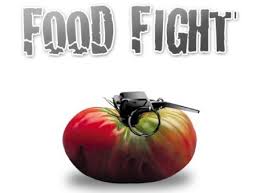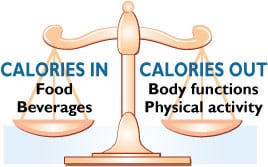 |
| Image: www.foodfightthedoc.com |
Are you ready for a food fight?! Sorry to disappoint if scenes from
Animal House are running through your mind, because it's not that kind
of fight to which I'm referring. The GMO conflict is waging on and at
the risk of sounding overly dramatic, the very essence of our food and
our health is at stake. One ongoing battle front for concerned American
consumers is the call for GM food labeling. Unlike most other
industrialized countries, the US doesn't label GM foods (1).
Just what is a GMO? -
I've posted about GM foods in the past, but in case you missed those posts (found
here and
here), I'll just briefly explain that GMO or GM are acronyms for
Genetically
Modified
Organism. You may also see GE used, and this stands for
Genetically
Engineered.
GM foods are the result of taking specific selected gene(s) from one
kind of organism and placing them into a related or unrelated organism
(2). According to the World Health Organization (WHO), GMO's contain
genetic material that "has been altered in a way that does not occur
naturally" (2). In other words, not "present in, or produced by nature"
(8).
"It's not nice to fool mother nature" -
What's
wrong with the good, old, conventional, natural methods of breeding our
crops? Well, it's seems they're just too time consuming
and not very accurate. Never mind that this is how nature works. Biotechnology now allows scientists to modify
plants in a lab in order to
enhance certain desirable traits for crops such as drought tolerance and
pest and
disease resistance. For example, scientists can take a gene
from a bacterium that is resistant to an herbicide like Roundup and
insert it into a soybean plant cell to create a Roundup resistant
soybean (1). This is viewed as a major benefit to farming because now
farmers are able to plant these Roundup resistant GM seeds, known as
"Roundup ready" seeds, and then use Roundup to kill the weeds without
harming the crops. Are you sensing a theme here? The company that patented the Roundup ready seeds also patented the Roundup.
Well, I'm sure it will come as
no surprise to you to learn that there's more to the story, but that's for another post. For now, it might be helpful to know
how The World Health Organization answers the question of why foods are
being genetically modified. After all, they are looking out for the world's health. Here's what they have to say:
"GM foods are developed – and marketed – because there is some perceived advantage either to the producer or consumer of these foods. This is meant to translate into a product with a lower price, greater benefit (in terms of durability or nutritional value) or both." [emphasis added]
Hmmm... Let's briefly examine two of the reasons stated in the WHO statement for why GM foods are developed and marketed:
- product with a lower price
- product with a greater benefit (durability or nutritional value or both)
Is less expensive food of greater benefit nutritionally? -
A
product with a lower price that has a greater benefit than a product
with a higher price would be outstanding. I love a bargain, but I'm no economist. However, it's
probably safe to say most of us would agree that getting something
valuable for a lesser cost seems like a good thing. So, in an effort to make
food cheaper and more abundant, cost effective and time efficient
farming practices have evolved over the decades. GM crops are one
result. Some advantages of GM foods are pest and disease resistance,
herbicide as well as cold, heat and drought tolerance, and even greater
nutritional benefit (3). On the other hand, as a very wise biology
professor once said, "for every yin, there's a yang", or put another
way, for every benefit, there's a consequence.
Admittedly, the modernization and
industrialization of farming practices have brought prices down
significantly on some foods. But ultimately at what cost? Consider that
the top GM crops are corn and soy which go into many processed foods (9). In
fact, "thousands of products on supermarket shelves are made with
ingredients from genetically modified crops" (9). For example, high
fructose corn syrup or soy protein is used frequently in the manufacture
of prepackaged convenience foods. Yes, the benefits of these foods are
that they're cheap and convenient, but there are consequences as well.
A
2006 report from the USDA Economic Research Service revealed
some interesting statistical trends on the percent of income American's
spent on food over the last 70 years. In 1930, Americans spent 24.2% of
their
income on food, compared with 9.5% in 2004 (4). Slate has broken it down
further by food eaten at home and compared the percentages by country
 |
| Image from: Slate.com |
(shown in the bar graph at right). The point being, Americans are
paying a lower price for their food than at any other time in history
and are also spending less than most countries. If, as WHO states, GMO's
are being developed and marketed as products with a nutritional
benefit, is the benefit being reflected in the public health? Are Americans
healthier?
The fact is obesity rates in America are at the highest rates
ever recorded and the diseases that correspond with being
overweight/obese are increasing dramatically (5). You can check out the
Center for Disease Control and Prevention's (CDC) interesting animated
map
here,
that shows by state how obesity rates have increased since 1985. The
map illustrates that during the past 20 years, "there has been a
dramatic increase in obesity in the United States and rates remain high.
In 2010, no state had a prevalence of obesity
less than 20%. Thirty-six states had a prevalence of 25% or more and 12 of these states had a prevalence of 30% or more" (5).
Is the American penchant for inexpensive, fast, processed
and
prepackaged, GM foods coming with the unexpected cost of diminishing
health
and rising health care costs? According to the US
Surgeon General, "Obesity is the fastest growing cause of disease and
death in
America" (6). "One out of every eight deaths in America is caused by an
illness directly related to overweight and obesity" and this statement
was made back
in 2003 (6). Sadly, things haven't improved since then. Does the cheaper cost of GM foods balance out the health care costs of poor nutrition? According to
the National Institutes on Health, "on average,
people who are considered obese pay 42% more in health care costs than
normal-weight individuals" (7). Is there really a lower
price/increased nutritional benefit to GM foods?
GM food labeling-
Considering the
above information, the critical factor in maximizing our potential for
good health is good nutrition. This is only possible by having access to
healthy foods and having the ability to make informed decisions about
what foods we choose to eat. The fact that GM foods are not labeled in
the US makes this impossible. Bearing in mind a 2008 survey,
found here,
which showed 87% of Americans polled felt labeling of GM food was necessary,
it would seem that the US government would enact a GMO labeling policy.
This has been proposed, but unfortunately still not enacted and surely standing to benefit most from GM foods will continue to insist the labeling of GM foods is unnecessary. Considering
the mounting research that shows evidence of harm from GMO's (10), it seems prudent to
let our government officials know that we feel the labeling of our foods
is highly important.
The following statement sums up succinctly the importance of making healthy food choices:
"Every day,
several times a day, you make food choices that influence your body's
health for better or worse. Each day's choices are repeated over years
and decades, the rewards or consequences become major. That being the
case, paying close attention to good eating now can bring you health
benefits later" (5).
Tips to Avoid GMO's:
So,
until GM food labeling becomes a reality, and this is a big question
mark right now, you will have to do a little due diligence to avoid
GMO's. You can limit your consumption of GMO's by making careful food
choices. Here are a few suggestions for ways to avoid GM foods:
- Steer clear of the top 4 at risk ingredients found in prepackaged, processed convenience foods - corn, soy, cottonseed and canola.
- Try to buy organic foods when possible.
- Try to buy only grass fed meat or wild caught fish. Feed fed cattle and farm raised fish are likely to be fed GM food.
- Watch out for GM sugar beet sugar which is on the market now.
For more suggestions visit the
True Food Shopper's Guide, which includes specific name brand non GMO foods to buy or GM foods to avoid. They even have an app available for your smart phone. Lastly, please consider signing the petition found at the
Institute for Responsible Technology. We need to let President Obama know that Americans want meaningful GM food labeling now, because the stance the US government
seems to be taking to human consumption of GMO's is that they are
innocent until proven guilty. This principle may work for the justice
system, but seems reckless when applied to our food supply, especially
considering how absolutely crucial food is to our health and very survival.
Sources
(1)
Wikipedia, Genetically modified organisms, Retrieved from
http://en.wikipedia.org/wiki/Genetically_modified_organism August 2011
(2) World Health Organization, Food Safety
retrieved from
http://www.who.int/foodsafety/publications/biotech/20questions/en/
August 2011
(3) Whitman, D. B., Genetically
Modified Foods: Harmful or Helpful? April 2000, Retrieved from
http://www.csa.com/discoveryguides/gmfood/overview.php August 2011
(4) US Department of Agriculture Economic Research Service Retrieved from http://www.ilfb2.org/fff06/51.pdf August 2011
(5)
Centers for Disease Control and Prevention (CDC), Retrieved from
http://www.cdc.gov/obesity/data/animated_map_slides/map26.jpg August
2011
(6) US Surgeon General Statement
(7)
US Department of Health & Human Services National Institutes of
Health, WIN, Retrieved from
http://www.win.niddk.nih.gov/statistics/index.htm#overweight August 2011
(8) Free Dictionary, natural, Retrieved from www.thefreedictionary.com/natural, August 2011
(9) True Food Now, Retrieved from http://truefoodnow.org/shoppers-guide/ on August 2011
(10)
Responsible Technology, The Campaign for healthier eating in America,
Retrieved from http://www.responsibletechnology.org/docs/140.pdf August 2011











